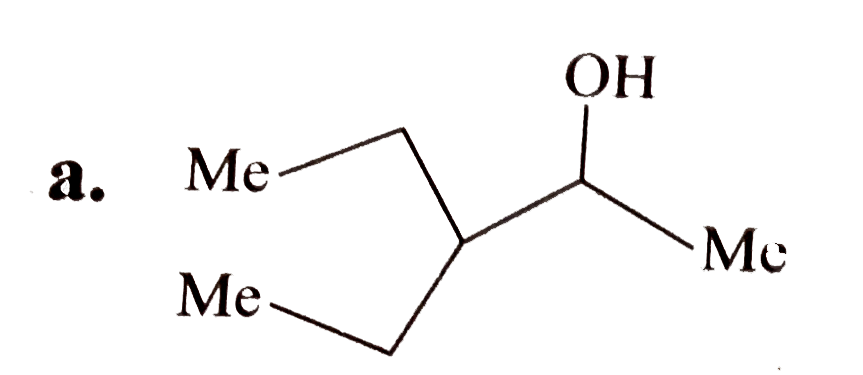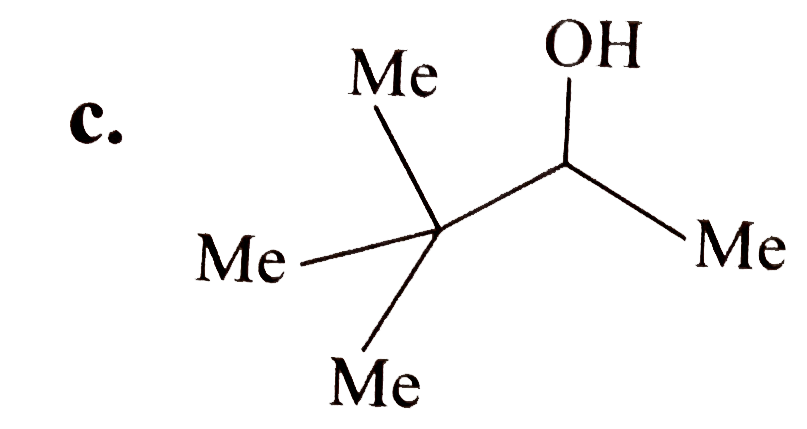(a) Give the products of the reaction of KOH with
(i) C4H9Br
(ii) C2H5CHBrCH3
(iii) Me3CBr
(b) Give the reactivity order.
(c) Give the factors that determine the major product.
Step-by-Step Solution
1. For C4H9Br (Butyl bromide):
- This is a primary alkyl halide.
- When treated with aqueous KOH, it undergoes an SN2 reaction.
- The product formed is Butanol (C4H9OH).
- Reaction:
\(
CH_3CH_2CH_2CH_2Br + KOH \rightarrow CH_3CH_2CH_2CH_2OH + KBr
\)
2. For C2H5CHBrCH3 (Isobutyl bromide):
- This is a secondary alkyl halide.
- It will also undergo an SN2 reaction with aqueous KOH.
- The product formed is Isobutanol (C2H5CHOHCH3).
- Reaction:
\(
CH_3CH(CH_3)CH_2Br + KOH \rightarrow CH_3CH(CH_3)CHOH + KBr
\)
3. For Me3CBr (Tert-butyl bromide):
- This is a tertiary alkyl halide.
- In the presence of aqueous KOH, it typically undergoes an elimination reaction (E1) rather than an SN2 reaction.
- The product formed is Isobutylene (C4H8), which is an alkene.
- Reaction:
\(
(CH_3)_3CBr + KOH \rightarrow (CH_3)_2C=CH_2 + KBr + H_2O
\)
(b) Reactivity Order:
- The reactivity order for the SN2 reaction is:
\(
\text{Primary} > \text{Secondary} > \text{Tertiary}
\)
- For the E1 reaction, tertiary alkyl halides are more reactive than secondary and primary.
(c) Factors that determine the major product:
1. Nature of Alkyl Halide:
- Primary and secondary alkyl halides favor SN2 reactions, while tertiary alkyl halides favor E1 reactions.
2. Temperature:
- Higher temperatures favor elimination reactions (E1), while lower temperatures favor substitution reactions (SN2).
3. Polarity of the Solvent:
- Polar protic solvents can stabilize ions and favor E1 reactions, while polar aprotic solvents favor SN2 reactions.
- This is a primary alkyl halide.
- When treated with aqueous KOH, it undergoes an SN2 reaction.
- The product formed is Butanol (C4H9OH).
- Reaction:
\(
CH_3CH_2CH_2CH_2Br + KOH \rightarrow CH_3CH_2CH_2CH_2OH + KBr
\)
- This is a secondary alkyl halide.
- It will also undergo an SN2 reaction with aqueous KOH.
- The product formed is Isobutanol (C2H5CHOHCH3).
- Reaction:
\(
CH_3CH(CH_3)CH_2Br + KOH \rightarrow CH_3CH(CH_3)CHOH + KBr
\)
- This is a tertiary alkyl halide.
- In the presence of aqueous KOH, it typically undergoes an elimination reaction (E1) rather than an SN2 reaction.
- The product formed is Isobutylene (C4H8), which is an alkene.
- Reaction:
\(
(CH_3)_3CBr + KOH \rightarrow (CH_3)_2C=CH_2 + KBr + H_2O
\)
- The reactivity order for the SN2 reaction is:
\(
\text{Primary} > \text{Secondary} > \text{Tertiary}
\)
- For the E1 reaction, tertiary alkyl halides are more reactive than secondary and primary.
1. Nature of Alkyl Halide:
- Primary and secondary alkyl halides favor SN2 reactions, while tertiary alkyl halides favor E1 reactions.
2. Temperature:
- Higher temperatures favor elimination reactions (E1), while lower temperatures favor substitution reactions (SN2).
3. Polarity of the Solvent:
- Polar protic solvents can stabilize ions and favor E1 reactions, while polar aprotic solvents favor SN2 reactions.
Topper's Solved these Questions
- BOOK - CENGAGE CHEMISTRY ENGLISHCHAPTER - ORGANIC REACTION MECHANISMEXERCISE - Solved Example33videos
ORGANIC REACTION MECHANISM
- BOOK - CENGAGE CHEMISTRY ENGLISHCHAPTER - ORGANIC REACTION MECHANISMEXERCISE - Subjective19videos
ORGANIC REACTION MECHANISM
- BOOK - CENGAGE CHEMISTRY ENGLISHCHAPTER - NCERT BASED EXERCISEEXERCISE - Chemical Equilibrium73videos
NCERT BASED EXERCISE
- BOOK - CENGAGE CHEMISTRY ENGLISHCHAPTER - P-BLOCK GROUP 13 - BORON FAMILYEXERCISE - Exercise Archives (Subjecive)9videos
P-BLOCK GROUP 13 - BORON FAMILY
Similar Questions
Knowledge Check
- Question 1 - Select One
Aniline reacts with excess Br2/H2O to give the major product
A1. 2-bromoanilineB2. 4-bromoanilineC3. 2,4-dibromoanilineD4. 2,4,6-tribromoaniline - Question 2 - Select One
The reaction of C6H5CH=CHCHO with NaBH4 give:
AC6H5CH2CH2CH2OHBC6H5CH=CHCH2OHCC6H5CH2CH2CHODC6H5CH2CHOHCH3
Give the products formed on hydrolysis of (a) Al4C3 and (b) CaNCN.
View SolutionGive the products of the reaction with conc. H2SO4 of :
a.
b.
c.
d. 1- Methyl cyclohexanolView SolutionArrange the following in the decreasing order of their boiling points: (i) C2H5Br (ii) C2H5Cl (iii) C2H5I
View SolutionIdentify the major product in the following reactions :
(i)
(ii) C6H5COOH+CH3MgI→?+?.View Solution3-Phenylpropene on reaction with HBr gives (as major product)
View Solutiona. Give the structure of lowest molecular mass and optically active alkyne.
b. Give the structure of unsaturated hydrocarbon with lowest molecular mass showing diastereomers.
c. Give the structure of alkyne that gives the same product on reaction with either H2+Ni2B or K+C2H5OH.
d. Give the structure of alkyne that gives the same single product on reaction with either (B2H6/THF+H2O2/ӨH) or dil. H2SO4/Hg2+/H⊕.
e. Give the structure of alkyne that gives the same two products with either of the reagents in (d).View Solution


